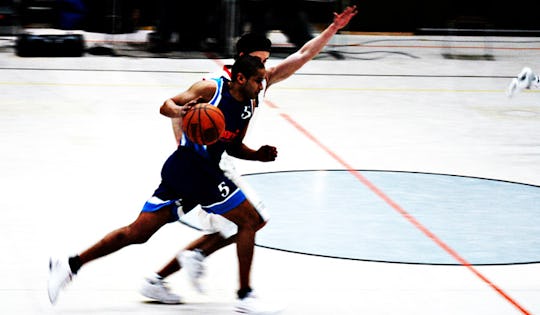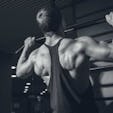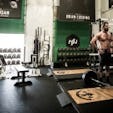You start training at a very young age when you grow up in a small town with not much to do but play sports. I can remember when I was in the third grade, I fell in love with basketball. Not a day went by that I didn’t shoot, dribble, pass the ball, or practice jumping.
I learned from the start that I wasn’t going to be the tallest guy on the court, but I wanted to be the guy on the court that could dunk the ball. Unfortunately, all I had to practice with was the staircase in my house.
I would do calf raises and the standing long jump, marking the stair that I landed on and trying to improve everyday. This was my starting point, and I was just eight years old (it’s not hard to see why I became a trainer).
As I was improving my jumping, I would try to touch the net, and when I did so, I would mark which loop I hit. I also started doing bounding and plyobox drills in the backyard; my parents and neighbors all thought I was crazy but this paid off.
By the seventh grade I could grab the rim. I remember the first time was during lunch break and the whole basketball team was on one court. Everyone was taking their turn trying to grab the rim. I tried and the first couple times were close and my fellow teammates started cheering me on. Then it happened, I went up and pulled the rim. It was the best day that I could remember. From that point on, I never stopped working on my jumping and I kept getting better and improving every time. By the ninth grade, I could stand right under the rim with a basketball and jump straight up and dunk the ball; very impressive for someone with a height of only 6 feet. All the vertical and broad jumping, as well as agility and speed work, had paid off.
Unconventional Fitness for Basketball Athletes
When I train my basketball players, the key things I work on is improving their power, agility, speed, strength, and conditioning. Those are the main staples that will make them more explosive athletes and improve their sport skills. I look at basketball players as incredible athletes; they are fast, agile, explosive, and have excellent endurance.
When training basketball players, we do a lot of plyometric training which includes hurdles, ladders, cones, box jumps, and flex bands for sprints and shuffles. This helps them build power, agility and acceleration.
Strength Training for Basketball
For strength, we use kettlebells, sandbags/sandbells, and tires to put on muscle and become stronger in the paint. Some kettlebell exercises include: cleans, thrusters, swings, and squat jumps. With the sandbags/sandbells, I like to use rows, thrusters, front squats, and the clean and press. The sandbells are a key training tool for slams to the ground, throwing, and passing, as well as core work. With the tires, we use different sizes for flipping, dragging, rowing, pulling, and throwing.
Reaction Training for Basketball
Something else that a lot of people forget to add is reaction training. With basketball players, this is something that needs to be incorporated into the program to teach the athlete hand/eye coordination. I like using the reaction balls that have six knobs on the ball; when you bounce them you never know which direction they will go. This makes the athlete focus on the ball and get used to being in a defensive position in order to react when the ball bounces.
Unconventional Training Secret Weapon: Medicine Ball
Medicine ball throws are one of the workouts that will help give the athlete explosive power and should be done once every other week. Athletes never really get accustomed to medicine balls; you see athletes simply handing the ball off or tossing it back and forth. This is the wrong way to use medicine balls; they need to be thrown and beat. I like to use them with four exercises that cause you to throw and launch the ball using maximum force.
Doing underhand scoops, throw the ball as far as you can; with overhead throws, do the same thing. Perform chest passes along with side-to-side passes to give you enhanced core strength and explosive power. When you are training with medicine balls, throw them, launch them in the air and forget about handing them off or tossing them back and forth, that will get you nowhere. When you get good at these drills, you can incorporate plyo jumps to the medicine ball throws to give you speed, power, and form you into a deadly athlete.
Unconventional Fitness Training Schedule
The training schedule for basketball players looks like this: during the season, train twice a week spending on foot work, plyo drills, and strength. We are not looking to add size during this period, just maintain and keep the muscle and size that we added in the off season. We do, however, want to become faster and jump higher, so this training should always be progressing.
Plan on adding size and strength in the off season. The training should be bumped up to four times a week and focus mostly on strength. Stretching is a key staple in our athlete training and is done before and after every training session. You want your athletes to have great flexibility and a better range of motion.
Unconventional Fitness Workouts
The following are a couple of sample workouts that I have used to enhance basketball player prowess.
Jump Higher, Run Faster: Workout 1
A: Jump Rope – 1 x 2 min
B1: Battle Rope Slams – 4 x 1 min
B2: Ladder Drills – 4 x 1 min
B3: Kettlebell Swings – 4 x 15-20
B4: Kettlebell Squat/Press – 4 x 15-20
B5: Box Jumps – 4 x 8-10
Jump Higher, Run Faster: Workout 2
A: Jump Rope – 1 x 2 min
B1: Tire flips – 4 x 8-10
B2: Sandbell Slams – 4 x 15-20
B3: Hurdle Jumps – 4 x 12
B4: Sandbag Bent Rows – 4 x 15-20
B5: Band Sprints/Shuffles – 4 x10-15

)





